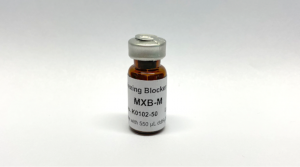FluoTag®-X2 anti-Mouse Ig kappa light chain
195,00 €
FluoTag®-X2 anti-Mouse Immunoglobulin kappa light chain is a species-specific FluoTag® directed against the kappa light chain from Mouse. Especially useful for One-step immunofluorescence (IF) and Multiplexing applications.
In most research monoclonal antibodies are generated in mice. These animals have a rich repertoire of immunoglobulins (Ig) displaying various isotypes (IgA, IgD, IgG, IgE, and IgM). Mice IgGs can be further categorized into five subclasses IgG1, IgG2a, IgG2b, IgG2c, and IgG3. In addition to the subclasses, each IgG molecule can be equipped with either a lambda or kappa light chain.
Our sdAbs anti-mouse KLC specifically binds to all mouse Ig isotypes carrying a kappa light chain.
FluoTags® can be equipped with a single fluorophore for more quantitative readouts (FluoTag®-Q), with two fluorophores per single-domain antibody (FluoTag®-X2), and we also developed a blend of two sdAbs bindings simultaneously the target proteins and each bearing two fluorophores (FluoTag®-X4). For more detailed information on the FluoTags, please check our Technology Section.
| Variations: |
|
||||||||||||||||||||||||||||||||
|---|---|---|---|---|---|---|---|---|---|---|---|---|---|---|---|---|---|---|---|---|---|---|---|---|---|---|---|---|---|---|---|---|---|
| Related Products: | |||||||||||||||||||||||||||||||||
| Clone: | 1A23 | ||||||||||||||||||||||||||||||||
| Host: | Alpaca | ||||||||||||||||||||||||||||||||
| Produced in: | E. coli | ||||||||||||||||||||||||||||||||
| Application: | IF, WB | ||||||||||||||||||||||||||||||||
| Dilution: | 1:500 (corresponding to 10 nM final concentration if the sdAb was reconstituted as proposed bellow). | ||||||||||||||||||||||||||||||||
| Capacity: | - | ||||||||||||||||||||||||||||||||
| Antigen: | - | ||||||||||||||||||||||||||||||||
| Targets: | Mouse kappa light chain | ||||||||||||||||||||||||||||||||
| Specificity: | Specifically recognizes Mouse Immunoglobulin kappa light chains. Does not cross-react with antibodies from species like Rat, Guinea Pig, Rabbit, Chicken or Goat. | ||||||||||||||||||||||||||||||||
| Formulation: | The single sdAb clone was lyophilized from PBS pH 7.4 containing 2% BSA (US-Origin). Reconstitute with 500 µl of 50 % glycerol in deionized water. We recommend including 0.1 % sodium azide as a preservative if applicable. When reconstituted with 500 µl, the single-domain antibody concentration is 5 µM. | ||||||||||||||||||||||||||||||||
| kDa: | - | ||||||||||||||||||||||||||||||||
| Ext Coef: | - | ||||||||||||||||||||||||||||||||
| Shipping: | Ambient temperature | ||||||||||||||||||||||||||||||||
| Storing: | Vials containing lyophilized protein can be stored at 4 °C for 6 months. We recommend reconstituting the protein with 50 % sterile glycerol including 0.1 % sodium azide as preservative if applicable. Minimize the number of freeze-thaw cycles by aliquoting the reconstituted protein. Long term storage at -80 °C for up to 6 months. Working aliquots can be stored at -20 °C for up to 4 weeks. We do not recommend storing the reconstituted protein at 4 °C. | ||||||||||||||||||||||||||||||||
| Protocols: |
Suggested general protocols for immunofluorescence can be found in our Resource Section. One-Step immunofluorescence and multiplex staining can be performed with our smart secondaries. Here you can find more on these technologies One-Step-IF & Multiplexing. |
||||||||||||||||||||||||||||||||
| References: |
|
||||||||||||||||||||||||||||||||
| Notice: | To be used in vitro/ for research only. Non-toxic, non-hazardous, non-infectious. | ||||||||||||||||||||||||||||||||
| Legal terms: | By purchasing this product you agree to our general terms and conditions. |




